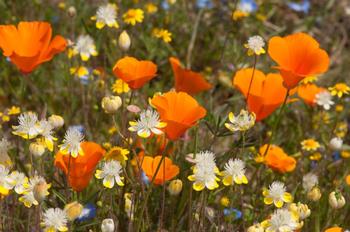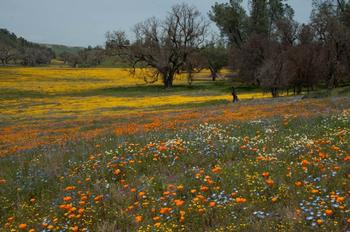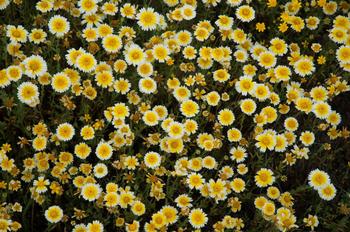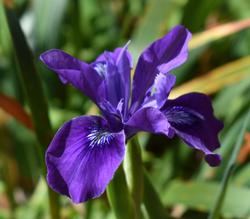Winter 2023
Now Is the Time to Plant Natives in Your Garden!
by Robin Mitchell

With the start of the rains in the Bay Area (thank goodness), this is a good time to incorporate native plants into your garden.
There are so many possibilities between California native annuals and perennials, it can be somewhat daunting to start. The California Native Plant Society has a web-based tool called Calscape, which can be used to identify local native plants by typing in a zip code. Each plant has a detailed description about sun exposure, soil type, butterflies and moths it supports, as well as nurseries that sell the plant.
Annuals
For annuals, wildflower blooms in natural areas can be an inspiration. For example, the super bloom at Carrizo Plain in 2019 was spectacular.
It is possible to get at least some of that wildflower wonder in gardens and other landscaped areas. As well as being beautiful, these native plants also support many insects and wildlife, and so contribute to ecosystem health.
Some annuals that work well in gardens and can reseed under the right circumstances are Tidy Tips (Layia platyglossa), Baby Blue Eyes (Nemophila menziesii), California Goldfields (Lasthenia californica), Phacelia (such as Lacy Phacelia, Phacelia tanacetifolia), and Lupine (such as Arroyo Lupine, Lupinus succulentus).

Here are some tips for how to successfully grow California native annual wildflowers. It may be useful to use both methods together for the best results.
- Broadcast seed: One method is to “broadcast”, or scatter, seed in the garden. Make sure not to provide a gourmet meal for the birds and squirrels. Dig the seeds in a bit so birds have a harder time finding them. Chicken wire can be used to cover smaller areas that need protection from critters. But don’t dig them in too deeply, as many of the seeds are very small.
- Start in 4-inch pots and transplant the seedlings: Starting seeds in pots is another method because it is easier to provide just the right conditions for the seeds to germinate and to keep them protected. Once the seedlings have their secondary leaves and have reached a height of three to four inches, they can be transplanted. If the seedlings are thick in the pot, they can be separated into quarters and those quarter sections can be planted directly into the ground. That simulates what can happen when seed is broadcast unevenly: you can get a thick growth of wildflowers in some areas. The drawback to transplanting seedlings from pots is that you don’t get the wide swath of flowers you can get from broadcasting the seeds.

- Weed control: Because in most gardens there can be many weeds (ie, native or non-native plants that are not desired), some site preparation is needed to turn your garden into a native wonderland. For annuals in particular, in order for them to come back year after year, they need to be able to reseed, which means they need reduced competition from weeds. Weeding ahead of seeding helps, but as soon as the ground gets watered, weeds will grow. It is important to be able to distinguish between weeds and wildflowers! That is another advantage of growing at least a few of the seeds in 4-inch pots to see what the seedlings of each plant look like.
Perennials
In addition to annuals, this is a great time to plant California native perennials. They can be started from seed but generally take much longer to germinate and grow to a size that can be transplanted, so buying perennials from a nursery is advisable. There are many nurseries in Contra Costa County that either specialize in native plants or have them in their inventory. Make sure that the plants have not been treated with pesticides such as neonicotinoids, as these can be toxic to the insects that are attracted to the plants.

Many perennials prefer sun, but others can be planted under trees, such as home orchards (which will help with pollinating the fruit), including western columbine (Aquilegia formosa), pink flowering currant (Ribes sanguineum var. glutinosum), and red-flowered buckwheat (Eriogonum grande var. rubescens, endemic to the Channel Islands and very drought tolerant). A groundcover that can tolerate light shade is woodland strawberry (Fragaria vesca), which seem to hold their own against the invasive Bermuda Buttercup or Sourgrass (Oxalis pes-caprae) which is very pervasive in the Bay Area.
Many natives can be grown in the shadiest areas of the garden, such as Douglas Iris (Iris douglasiana, which can be grown from seed resulting in the natural genetic variation in flower color), Blue Eyed Grass (Sisyrinchium bellum), and Peppermint Candy Flower (Claytonia sibirica). These are all reliable bloomers.
The rainy season in our area is when all our natives shine, so happy planting!
